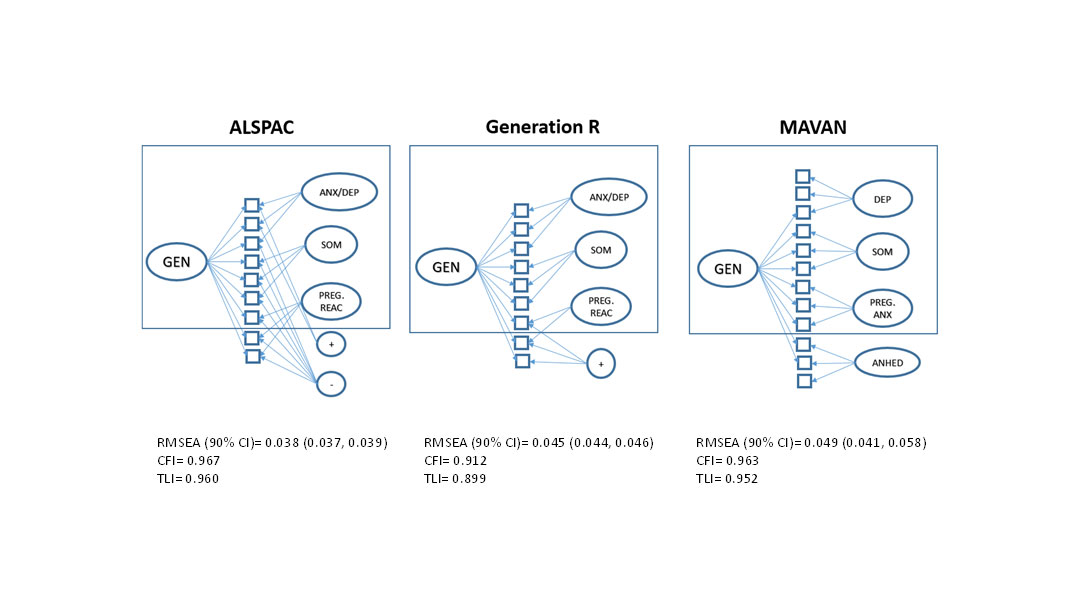The idea that adverse experiences often occur in multitude is not new. The pioneering Adverse Childhood Experiences Study (ACE Study) surveyed childhood trauma in over 17 000 people for more than 15 years and found that adverse childhood experiences are common and often occur together: about two-thirds of the adults asked in the study had reported one or more types of adverse childhood experiences. Of those, 87 percent had experienced two or more. More adverse childhood experiences resulted in a higher risk of medical, mental and social problems as an adult (see ref 1.)
Given that crucial developmental processes take place well before birth, the prevailing idea is that mothers’ adverse environmental experiences could indirectly affect the developing fetus through the placenta. In DREAMBIG, we focus on two main areas of prenatal adversity: social-economic adversity and maternal psychopathologies, such as anxiety or depression. Our collaborators in ALSPAC and Generation R have developed a prenatal cumulative environmental risk index, which survey’s women’s socioeconomic adversity during pregnancy in four major areas: stressful life events (such as death in family, accident, illness), contextual risks (such as poor housing conditions, financial problems), parental risks (such as substance abuse, criminal involvement), and interpersonal risks (such as family conflict, domestic violence)2,3. Risks in each domain are then aggregated into a cumulative environmental risk index. In DREAMBIG, we retained the four specific risk domains above, while, instead of summing them up, we simultaneously capture the variance that is shared across the four risk domains in a so called general adversity factor, the A-factor. To do this, we use confirmatory factor analysis with a bifactor structure, where each risk item contribute information to both their specific risk domain as well as the general adversity factor. This model is then compared to simpler as well as more complex models using model fit indices. These indices show that this bifactor model provides the best fit in ALSPAC, Generation R and MAVAN.

Harmonizing maternal affective psychopathology constructs during pregnancy
Maternal depression and anxiety during pregnancy has a demonstrated negative impact on the offspring’s mental health. Similarly to the environmental risks above, depressive and anxiety symptoms are very heterogeneous and include symptoms experienced at multiple areas of functioning, such as mood, sleep, appetite and cognitive functions. Nevertheless, these specific symptoms often co-occur, so does depression and specific forms of anxiety. Therefore, similarly to the socioeconomic adversity factor, we harmonized maternal affective constructs using a bifactor structure, which allowed each symptom to simultaneously contribute information to their respective specific latent construct and a more global construct, the M-factor, that indicates the general vulnerability of women to develop any kind of affective problems during pregnancy. Again, the fit of this model was compared against a series of simpler and more complex models in each cohort. Although the exact model structure differs slightly across the cohorts, the general factor and three specific factors (i.e., combined depression and anxiety; somatic symptoms; and pregnancy specific reactions/fears) seem to be generalizable across the different studies, which all used different measures to assess anxiety and depressive

References
- Felitti, V. J. et al. Relationship of childhood abuse and household dysfunction to many of the leading causes of death in adults. The Adverse Childhood Experiences (ACE) Study. J. Prev. Med. 14, 245–58 (1998).
- Cecil, C. A. M. et al. Environmental risk, Oxytocin Receptor Gene (OXTR) methylation and youth callous-unemotional traits: a 13-year longitudinal study. Psychiatry 19, 1071–7 (2014).
- Rijlaarsdam, J. et al. An epigenome-wide association meta-analysis of prenatal maternal stress in neonates: A model approach for replication. Epigenetics 11, 140–9 (2016).
